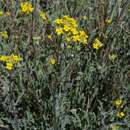en
names in breadcrumbs


Physaria is a genus of flowering plants in the family Brassicaceae. Many species are known generally as twinpods, bladderpods, or lesquerella. They are native to the Americas, with many species endemic to western North America. They are densely hairy annual and perennial herbs[1] often growing prostrate or decumbent, along the ground in patches or clumps. They bear inflorescences of bright yellow flowers. The fruit is often notched deeply, dividing into twin sections, giving the genus its common name.
Bladderpod oil is extracted from the seeds of Physaria fendleri and certain other species in the genus.[2]
Due to the presence of both annual and perennial herbaceous members, this genus has been used as a model for allocation pattern comparisons between the annual and perennial life cycle.[1]
Many of species of Physaria were formerly included in the now-defunct genus Lesquerella.
Species include:
Physaria is a genus of flowering plants in the family Brassicaceae. Many species are known generally as twinpods, bladderpods, or lesquerella. They are native to the Americas, with many species endemic to western North America. They are densely hairy annual and perennial herbs often growing prostrate or decumbent, along the ground in patches or clumps. They bear inflorescences of bright yellow flowers. The fruit is often notched deeply, dividing into twin sections, giving the genus its common name.
Bladderpod oil is extracted from the seeds of Physaria fendleri and certain other species in the genus.
Due to the presence of both annual and perennial herbaceous members, this genus has been used as a model for allocation pattern comparisons between the annual and perennial life cycle.
Many of species of Physaria were formerly included in the now-defunct genus Lesquerella.
Species include:
Physaria acutifolia—Sharpleaf twinpod Physaria alpestris—Washington twinpod Physaria alpina—Avery Peak twinpod Physaria arctica—Arctic bladderpod Physaria argyraea—Silver bladderpod Physaria bellii—Front Range twinpod Physaria brassicoides—Double twinpod Physaria chambersii—Chambers' twinpod Physaria condensata—Tufted twinpod Physaria congesta —Dudley Bluffs bladderpod Physaria didymocarpa—Common twinpod Physaria fendleri—Fendler's bladderpod Physaria filiformis—Missouri bladderpod Physaria floribunda—Pointtip twinpod Physaria fremontii—Fremont's bladderpod Physaria geyeri—Geyer's twinpod Physaria globosa—Globe bladderpod Physaria gordonii—Gordon's bladderpod Physaria grahamii—Graham's twinpod Physaria hemiphysaria—Intermountain bladderpod Physaria humilis—St. Marys Peak Bladderpod Physaria integrifolia—Bladderpod Physaria kingii—King bladderpod Physaria lepidota—Kane County twinpod Physaria ludoviciana—Foothill Bladderpod. Physaria navajoensis —Navajo twinpod Physaria obcordata—Dudley Bluffs twinpod (threatened) Physaria occidentalis—Western bladderpod Physaria okanensis—O'Kane's bladderpod Physaria oregona—Oregon twinpod Physaria pallida—White bladderpod Physaria parviflora—Piceance bladderpod Physaria parvula—Pygmy bladderpod Physaria pruinosa—Pagosa bladderpod Physaria purpurea—Rose bladderpod Physaria reediana—Alpine bladderpod Physaria repanda—Indian Canyon twinpod Physaria saximontana—Fremont County twinpod Physaria tenella—Moapa bladderpod Physaria thamnophila—Zapata bladderpod Physaria tumulosa—Kodachrome bladderpod Physaria vitulifera—Roundtip twinpod